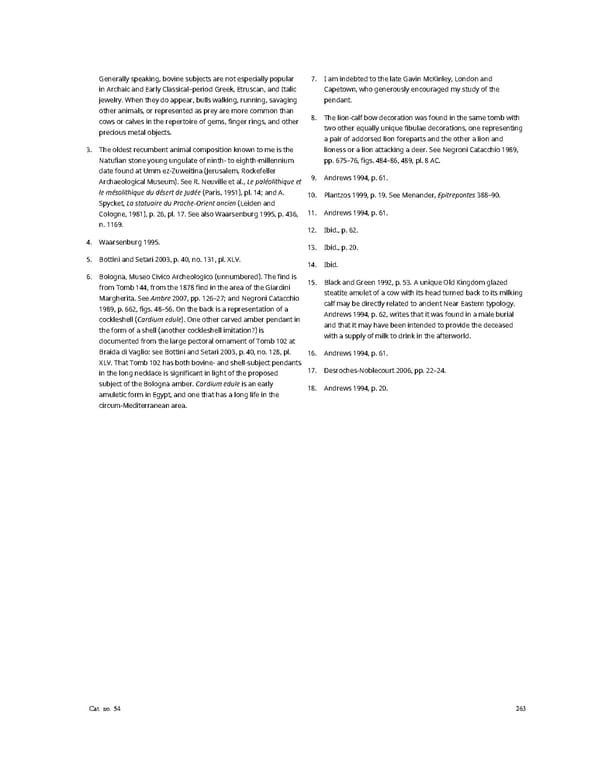Generally speaking, bovine subjects are not especially popular 7. I am indebted to the late Gavin McKinley, London and in Archaic and Early Classical–period Greek, Etruscan, and Italic Capetown, who generously encouraged my study of the jewelry. When they do appear, bulls walking, running, savaging pendant. other animals, or represented as prey are more common than 8. The lion-calf bow decoration was found in the same tomb with cows or calves in the repertoire of gems, finger rings, and other two other equally unique fibulae decorations, one representing precious metal objects. a pair of addorsed lion foreparts and the other a lion and 3. The oldest recumbent animal composition known to me is the lioness or a lion attacking a deer. See Negroni Catacchio 1989, Natufian stone young ungulate of ninth- to eighth-millennium pp. 675–76, figs. 484–86, 489, pl. 8 AC. date found at Umm ez-Zuweitina (Jerusalem, Rockefeller 9. Andrews 1994, p. 61. Archaeological Museum). See R. Neuville et al., Le paléolithique et le mésolithique du désert de Judée (Paris, 1951), pl. 14; and A. 10. Plantzos 1999, p. 19. See Menander, Epitrepontes 388–90. Spycket, La statuaire du Proche-Orient ancien (Leiden and Cologne, 1981), p. 26, pl. 17. See also Waarsenburg 1995, p. 436, 11. Andrews 1994, p. 61. n. 1169. 12. Ibid., p. 62. 4. Waarsenburg 1995. 13. Ibid., p. 20. 5. Bottini and Setari 2003, p. 40, no. 131, pl. XLV. 14. Ibid. 6. Bologna, Museo Civico Archeologico (unnumbered). The find is 15. Black and Green 1992, p. 53. A unique Old Kingdom glazed from Tomb 144, from the 1878 find in the area of the Giardini steatite amulet of a cow with its head turned back to its milking Margherita. See Ambre 2007, pp. 126–27; and Negroni Catacchio calf may be directly related to ancient Near Eastern typology. 1989, p. 662, figs. 48–56. On the back is a representation of a Andrews 1994, p. 62, writes that it was found in a male burial cockleshell (Cardium edule). One other carved amber pendant in and that it may have been intended to provide the deceased the form of a shell (another cockleshell imitation?) is with a supply of milk to drink in the afterworld. documented from the large pectoral ornament of Tomb 102 at Braida di Vaglio: see Bottini and Setari 2003, p. 40, no. 128, pl. 16. Andrews 1994, p. 61. XLV. That Tomb 102 has both bovine- and shell-subject pendants in the long necklace is significant in light of the proposed 17. Desroches-Noblecourt 2006, pp. 22–24. subject of the Bologna amber. Cardium edule is an early 18. Andrews 1994, p. 20. amuletic form in Egypt, and one that has a long life in the circum-Mediterranean area. Cat. no. 54 263
 Ancient Carved Ambers in the J. Paul Getty Museum Page 272 Page 274
Ancient Carved Ambers in the J. Paul Getty Museum Page 272 Page 274